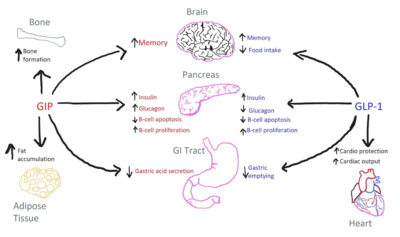User:Camille Gaudet/Sandbox 1
From Proteopedia
(Difference between revisions)
| Line 5: | Line 5: | ||
== Introduction == | == Introduction == | ||
=== History === | === History === | ||
| - | Investigation of pancreatic hormones began at the turn of the 20th century. In 1902, Bayliss and Starling discover a pancreatic [https://en.wikipedia.org/wiki/Secretin secretin] involved in regulation of water homeostasis, giving rise to interest in pancreatic hormones. Shortly after, in 1906, Moore et al. hypothesize involvement of [https://en.wikipedia.org/wiki/Gastrointestinal_hormone gastrointestinal hormone extracts] in maintenance of the endocrine pancreas. Jean La Barre purifies glucose-lowering gut extracts in 1929 and characterizes them as [https://en.wikipedia.org/wiki/Incretin incretins], which is short for intestine secretion insulin. Finally, in 1984, [https://en.wikipedia.org/wiki/Glucose-dependent_insulinotropic_polypeptide gastric inhibitory peptide] (GIP) is isolated from porcupine intestine. Although GIP was initially characterized for its gastric inhibitory effects (hence the name), it was also shown that the polypeptide played an integral role in [https://en.wikipedia.org/wiki/Insulin_signal_transduction_pathway insulin signaling and secretion]. Interestingly, it was found that the effect of GIP on insulin levels was still seen in its absence, hinting toward the presence of an additional incretin, which has now been classified as [https://en.wikipedia.org/wiki/Glucagon-like_peptide-1 glucagon-like peptide-1] (GLP-1). | + | Investigation of pancreatic hormones began at the turn of the 20th century. In 1902, Bayliss and Starling discover a pancreatic [https://en.wikipedia.org/wiki/Secretin secretin] involved in regulation of water homeostasis, giving rise to interest in pancreatic hormones. Shortly after, in 1906, Moore et al. hypothesize involvement of [https://en.wikipedia.org/wiki/Gastrointestinal_hormone gastrointestinal hormone extracts] in maintenance of the endocrine pancreas. Jean La Barre purifies glucose-lowering gut extracts in 1929 and characterizes them as [https://en.wikipedia.org/wiki/Incretin incretins], which is short for intestine secretion insulin. Finally, in 1984, [https://en.wikipedia.org/wiki/Glucose-dependent_insulinotropic_polypeptide gastric inhibitory peptide] (GIP) is isolated from porcupine intestine. Although GIP was initially characterized for its gastric inhibitory effects (hence the name), it was also shown that the polypeptide played an integral role in [https://en.wikipedia.org/wiki/Insulin_signal_transduction_pathway insulin signaling and secretion]. Interestingly, it was found that the effect of GIP on insulin levels was still seen in its absence, hinting toward the presence of an additional incretin, which has now been classified as [https://en.wikipedia.org/wiki/Glucagon-like_peptide-1 glucagon-like peptide-1] (GLP-1).<ref name ='Seino'>DOI:10.1111/j.2040-1124.2010.00022.x</ref> |
=== Biological Role === | === Biological Role === | ||
| - | [[Image:GIP-GLP1-Use.png|400 px|right|thumb|Figure 1. The biological roles of GIP and and GLP-1, incretin hormones.]] The GIP receptor (GIPR) helps facilitate the transport of glucose into/out of the cell through the stimulation of insulin secretion. <ref name='Sun'>PMID:35333651</ref>. GIPR is a type of [https://en.wikipedia.org/wiki/G_protein-coupled_receptor G-Protein Coupled Receptor] (GPCR), and its natural ligand, GIP, serves as an initiator of a cellular signaling cascade, thereby activating adenylyl cyclase and increasing cAMP levels. Subsequently, insulin secretion is stimulated. [https://en.wikipedia.org/wiki/Insulin Insulin], a peptide hormone, is secreted by the pancreas in response to glucose ingestion, allowing intake of glucose into the cell via the [https://en.wikipedia.org/wiki/GLUT2 Glut2] transporter. Notably, GIP, as well as GLP-1, serve a multitude of biological roles (Figure 1) other than insulin signaling. | + | [[Image:GIP-GLP1-Use.png|400 px|right|thumb|Figure 1. The biological roles of GIP and and GLP-1, incretin hormones.]] The GIP receptor (GIPR) helps facilitate the transport of glucose into/out of the cell through the stimulation of insulin secretion. <ref name='Sun'>PMID:35333651</ref>. GIPR is a type of [https://en.wikipedia.org/wiki/G_protein-coupled_receptor G-Protein Coupled Receptor] (GPCR), and its natural ligand, GIP, serves as an initiator of a cellular signaling cascade, thereby activating adenylyl cyclase and increasing cAMP levels. Subsequently, insulin secretion is stimulated. [https://en.wikipedia.org/wiki/Insulin Insulin], a peptide hormone, is secreted by the pancreas in response to glucose ingestion, allowing intake of glucose into the cell via the [https://en.wikipedia.org/wiki/GLUT2 Glut2] transporter. Notably, GIP, as well as GLP-1, serve a multitude of biological roles (Figure 1) other than insulin signaling.<ref name ='Seino'>DOI:10.1111/j.2040-1124.2010.00022.x</ref> |
Revision as of 00:06, 29 April 2024
Glucose-dependent Insulinotropic Polypeptide Receptor
| |||||||||||
References
- ↑ 1.0 1.1 1.2 Seino Y, Fukushima M, Yabe D. GIP and GLP-1, the two incretin hormones: Similarities and differences. J Diabetes Investig. 2010 Apr 22;1(1-2):8-23. PMID:24843404 doi:10.1111/j.2040-1124.2010.00022.x
- ↑ 2.0 2.1 2.2 2.3 Sun B, Willard FS, Feng D, Alsina-Fernandez J, Chen Q, Vieth M, Ho JD, Showalter AD, Stutsman C, Ding L, Suter TM, Dunbar JD, Carpenter JW, Mohammed FA, Aihara E, Brown RA, Bueno AB, Emmerson PJ, Moyers JS, Kobilka TS, Coghlan MP, Kobilka BK, Sloop KW. Structural determinants of dual incretin receptor agonism by tirzepatide. Proc Natl Acad Sci U S A. 2022 Mar 29;119(13):e2116506119. PMID:35333651 doi:10.1073/pnas.2116506119
- ↑ 3.0 3.1 Chavda VP, Ajabiya J, Teli D, Bojarska J, Apostolopoulos V. Tirzepatide, a New Era of Dual-Targeted Treatment for Diabetes and Obesity: A Mini-Review. Molecules. 2022 Jul 5;27(13):4315. PMID:35807558 doi:10.3390/molecules27134315
Student Contributors
- Camille Gaudet
- Sara Kalkhoff


